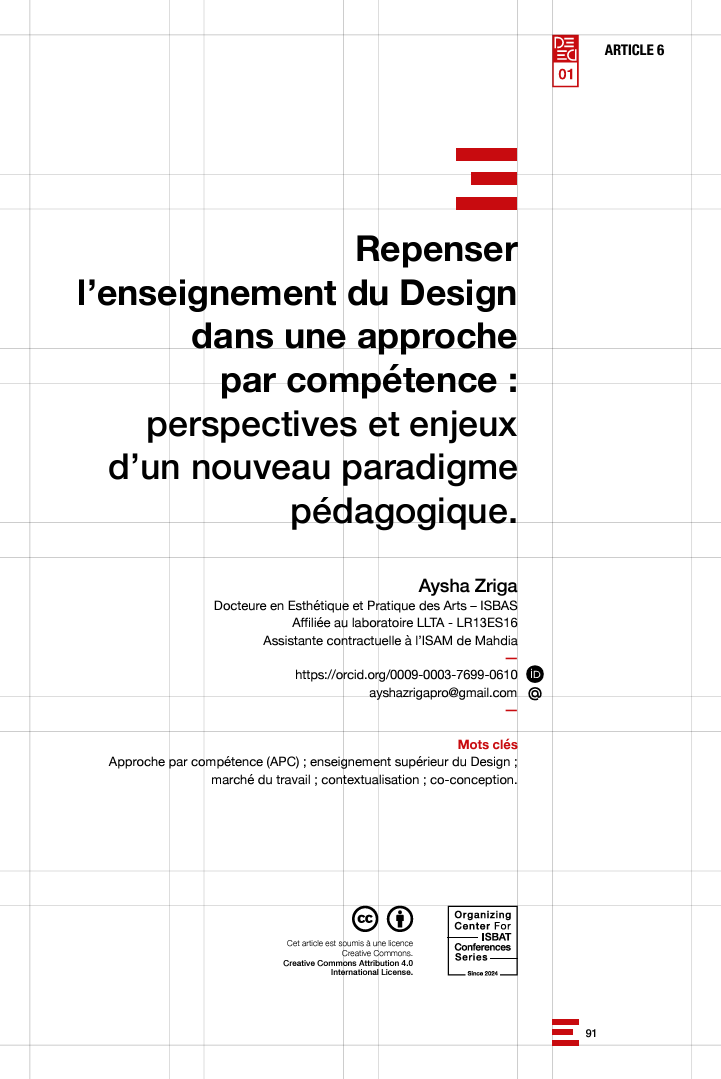Abstract
Design teaching at institutes in Tunisia - whether at the Instituts Supérieurs des Beaux-Arts or the Instituts Supérieurs des Arts et Métiers - commonly adopts an objective-based approach. Admittedly, this is an effective method for structuring learning in the discipline of Design, but it tends to privilege the transmission of theoretical knowledge (savoirs) and technical skills (savoir-faire) to the detriment of the development of disciplinary and cross-disciplinary competencies. From this perspective, the objective-based approach is becoming less and less suited to adequately preparing Design learners for the contemporary challenges of the job market. An alternative to this classic approach, one that is better suited to meeting employers' expectations, would be necessary to address the gaps facing design education today. In this sense, the competency-based approach would be an alternative whose potential and contributions we will explore. So, in this article, we question the potential of the transition from an objective-based approach to a competency-based approach in design education, in the sense that the latter would align learning in our institutes with the current demands of the job market. We will also discuss the contributions of this new pedagogical paradigm and the challenges of this transition.
References
ALTMAN, H., & Cashin, W. (1992), « Writing a syllabus. Kansas State University : Center for Faculty Evaluation and Development ».
BACHELARD. G (1967), La formation de l’esprit scientifique, Librairie philosophique J. VRIN, 5e Edition.
BILODEAU.H et al. (1999)« les objectifs pédagogiques dans les activités d’apprentissage de cours universitaires à distance », DistanceS vol3, n°2, Université de Québec en Abitibi-Témiscamingue. https://tecfaetu.unige.ch/staf/staf-k/cadillo/staf17/(LES%20OBJECTIFS_PEDAGOGIQUES_ DANS_LES_ACTIVITES).pdf
BLOOM, B., et coll.(1969), Taxonomie des objectifs pédagogiques, Tome 1, domaine cognitif. (Taxonomy of educational objectives, traduit de l'américain par Marcel Lavallée). Montréal, Education Nouvelle.
CHAUVIGNÉ, C et Coulet, J.C, (2010). L'approche par compétences : un nouveau paradigme pour la pédagogie universitaire. Revue française de pédagogie n°172.
Fontaine, S., & Loye, N. (2017). L’évaluation des apprentissages : une démarche rigoureuse. Pédagogie Médicale.
KOZANITIS, Anastassis. (2010). L’influence d’innovations pédagogiques sur le profil motivationnel et le choix de stratégies d’apprentissage d’étudiantes et d’étudiants d’une faculté d’ingénierie. Revue internationale de pédagogie de l’enseignement supérieur, (26-1) : http://ripes.revues.org/385?lang=en
PRÉGENT, R., BERNARD, H., KOZANITIS, A. (2011). Enseigner à l’université dans une approche-programme. Canada : Presses internationales Polytechnique.
TARDIF. J (2023), définition de la compétence, Former pour enseigner en supérieur, Univeristé Sherbook. https://cnam.scenari-community.org/siteWebBienDemarrer_220403/res/T6V1_Tardif.pdf
VIAL. S (2014), Le design, un acte de communication ? La Revue Hermès, Université de Nîmes Institut ACTE UMR 8218 – Université Paris 1 Sorbonne/CNRS.
Fiche de synthèse et pratique sur la motivation des étudiants produite par la DACIP de l'université de Lorraine https://sup.univ-lorraine.fr/files/2022/09/la_motivation_des_etudiants.pdf

This work is licensed under a Creative Commons Attribution 4.0 International License.
Copyright (c) 2024 Dr.


